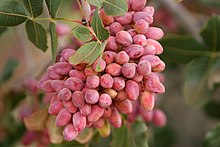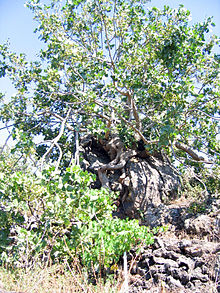Pistachio
| Pistacia vera | |
|---|---|

| |
| Scientific classification | |
| Kingdom: | Plantae |
| Clade: | Tracheophytes |
| Clade: | Angiosperms |
| Clade: | Eudicots |
| Clade: | Rosids |
| Order: | Sapindales |
| Family: | Anacardiaceae |
| Genus: | Pistacia |
| Species: | P. vera
|
| Binomial name | |
| Pistacia vera | |
The pistachio (Pistacia vera) is a small tree from the family Anacardiaceae (also known as the Cashew family). It is well known for it seeds that are eaten as food. It is native to the Middle East and Central Asia.[2]
The plant



The tree grows up to 10 m (33 ft) tall. It ts leaves are 10–20 centimeters (4–8 inches) long.
The fruit is a stone fruit. Only its seed is edible. The fruit has a hard, cream-colored exterior shell. The seed has a mauve-colored skin and light green flesh. When the fruit goes ripe, the shell goes from green to yellow or red and splits a bit open.[3] Different varieties split differently.
Pistachio trees can give 50 kilograms (110 lb) of seeds by average every two years.[4]
The shell of the pistachio is naturally a beige color, but it is sometimes dyed red or green. It is thought that dye was used by importers to hide stains on the shells when the seeds were picked by hand.[5] Most pistachios are now picked by machine and the shells do not have stains.
References
- ↑ Participants of the FFI/IUCN SSC Central Asian regional tree Red Listing workshop, Bishkek, Kyrgyzstan (11–13 July 2006) (2007). Pistacia vera. The IUCN Red List of Threatened Species 2007: e.T63497A12670823. doi:10.2305/IUCN.UK.2007.RLTS.T63497A12670823.en
- ↑ Walker, Harlan (1996). Cooks & Other People: Proceedings of the Oxford Symposium on Food and Cookery, 1995. Oxford Symposium. ISBN 978-0-907325-72-7.
- ↑ Towards a comprehensive documentation and use of Pistacia genetic diversity in Central and West Asia, North Africa and Europe, Report of the IPGRI Workshop, 14–17 December 1998, Irbid, Jordan – S.Padulosi and A. Hadj-Hassan, editors
- ↑ Nugent, Jeff; Julia Boniface (30 March 2005). "Pistachio Nuts". Permaculture Plants: A Selection. Permanent Publications. p. 41. ISBN 978-1-85623-029-2.
- ↑ Spiegel, Alison (2 February 2015). "Remember Red Pistachios? Here's What Happened To Them". The Huffington Post. Retrieved 12 February 2017.

